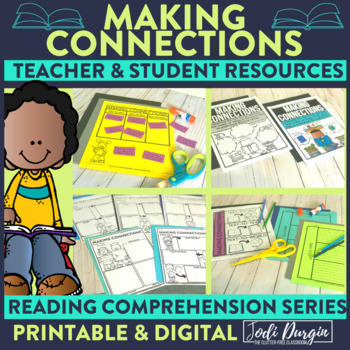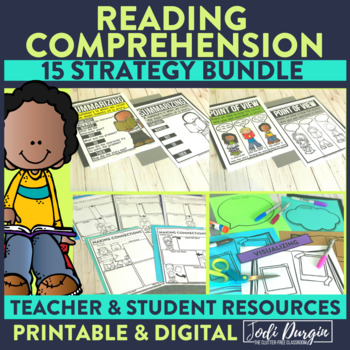Making connections is an important reading comprehension strategy for elementary students to become proficient in. When readers make connections, they use what they already know to make sense of a story. It helps readers better understand and enjoy stories they read and listen to by connecting it to their prior knowledge and experiences. Learn all about how to teach making connections in reading below!
What is Making Connections?
Making connections is a reading comprehension strategy where students rely on their background knowledge and prior experiences with a topic. When readers make connections, they are relating what they read to something they already know about. Readers will use what they already know to understand text that is confusing or difficult for them to understand. When students make connections, they are making sense of what they’ve read.
There are three different types of connections that readers make and it is important that students practice each. Perhaps the easiest type of connection to make is text to self. This is when students connect what they have read to their personal experiences and knowledge. Another type of connections readers make are text to text. Readers make text to text connections when they relate one book to another. The final type of connection is text to world and it is a bit more challenging for students. This is when we make connections about our community and world to what we are reading.
Why Is Making Connections an Important Comprehension Strategy?
Making connections is an important strategy for readers to understand what they are reading. If students can connect to what they read, they better understand the text. As a result, they will have a deeper comprehension of a text.
When students are making connections during reading, they are more engaged. This strategy gives students a purpose for their reading. It also requires readers to be actively involved and focused on the text.
Making connections to the text helps readers to remember what they read. They will have a better understanding of how characters are feeling. Students are able to empathize or share excitement with characters when they can relate to their experiences.
As students get older and text becomes more challenging, this reading strategy becomes more important. When reading to learn information, students will depend on any background knowledge they have about a topic. They will try and connect the new topic to any information they already know in order to make sense of the new information.
Teaching Standards for Making Connections
Standards for this reading comprehension topic include…
CCSS
- The Common Core State Standards do not specifically address making connections.
TEKS
- Grade 1
- ELA.1.6.E – The student is expected to make connections to personal experiences, ideas in other texts, and society with adult assistance.
- ELA.1.7A – The student is expected to describe personal connections to a variety of sources.
- Grade 2
- ELA.2.6.E – The student is expected to make connections to personal experiences, ideas in other texts, and society.
- ELA.2.7A – The student is expected to describe personal connections to a variety of sources.
- Grade 3
- ELA.3.6.E – The student is expected to make connections to personal experiences, ideas in other texts, and society.
- ELA.3.7A – The student is expected to describe personal connections to a variety of sources, including self-selected texts.
- Grade 4
- ELA.4.6.E – The student is expected to make connections to personal experiences, ideas in other texts, and society.
- ELA.4.7A – The student is expected to describe personal connections to a variety of sources, including self-selected texts.
- Grade 5
- ELA.5.6.E – The student is expected to make connections to personal experiences, ideas in other texts, and society.
- ELA.5.7A – The student is expected to describe personal connections to a variety of sources, including self-selected texts.
3 Tips for Teaching Students to Make Connections
Below are suggestions for when you teach your students to make connections when reading.
1. Read Aloud Picture Books
Reading aloud picture books is a great way to model and practice this reading comprehension strategy. There are tons of great read alouds out there for teaching students to make connections. Some high-quality examples include My Name is Yoon, The Relatives Came, Crown: An Ode to the Fresh Cut, Alice and Greta, and Ruby Finds a Worry.
2. Make Anchor Charts
Anchor charts are another great way to teach students about making connections when reading. My making connections resource includes an interactive anchor chart that successfully engages students in their learning and provides a visual learning experience for students to learn about making connections.
3. Use Videos
The third on the list of tips for teaching students to make connections is playing videos. This is another great visual learning opportunity for students to learn about what can feel like a very abstract idea. Below are some examples of videos that are great for teaching students how to make connections when reading picture books.
Making Connections Resources
These printable and digital resources for teaching elementary students about making connections make curriculum and lesson planning quick and easy. It includes teacher, parent, and student resources, so you’ll have everything you need to deliver meaningful research-based instruction rooted in current best practices.
What is Included
1. Teacher Resources
There are teacher notes about the strategy, teaching ideas, a planning page with question prompts, and list of mentor texts, so you have all of the information you need to plan a research and standards-based reading unit based on this reading comprehension strategy.
2. Parent Resources
There is a parent letter and a reading log with suggested question prompts so parents can confidently support and reinforce the strategy you are teaching with their children at home.
3. Instructional Resources
There are printables to create a large anchor chart and reference charts. Both save you lots of time searching for anchor chart ideas and supplemental teaching tools.
4. Student Resources
There are 3 printables and 2 activities for students that provide meaningful opportunities to practice and make sense of the reading strategy in a fun and engaging way.
5. Digital Resources
There are digital versions of several of the resources so students can access them in school or at home using a technology device of their choice.
Why Teachers Love this Resource
- This collection of resources is so versatile. Use it on it’s own or use it to supplement any reading curriculum. You will be able to continue to use these resources if your school adopts a new reading program or you switch school districts.
- This resource is part of a larger collection of reading strategy products, so you can provide a consistent instructional approach that your students quickly learn and understand the expectations and routines for. Learn more about this collection here!
- It’s a huge time saver! Instead of hunting for background information on a reading strategy and then searching for resources to teach the strategy, this comprehensive resource includes all of the information and resources you need to teach a whole unit on this reading strategy.
- The student activities are a lot of fun for students. This helps create a productive learning environment where students are engaged and learning!
- It includes resources that provide a great way to create a home-school connection with students’ families and support parents/guardians in continuing student learning at home.
In closing, we hope you found this post about how to teach making connections in reading helpful! If you did, then you may also be interested in this other post about elementary reading comprehension strategies.




